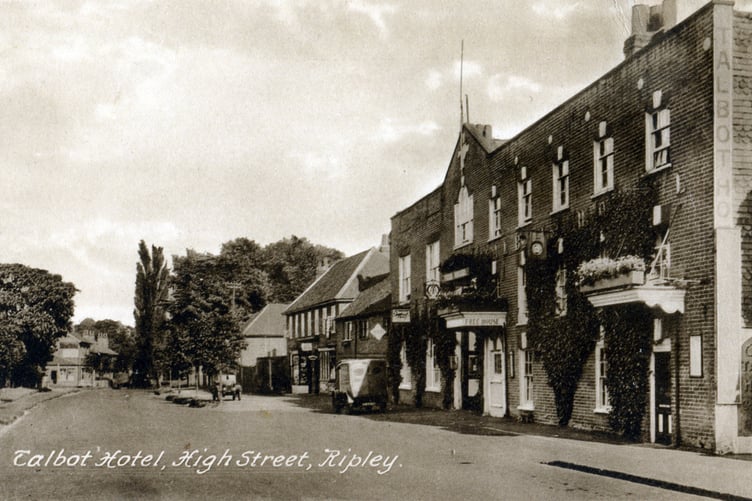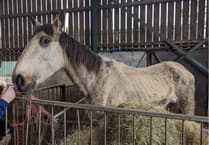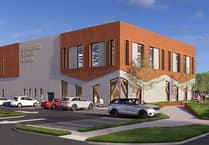For a bit of holiday reading I dipped into an old guide book, England In Colour, by Charles Bradley Ford, published in 1939 by Batsford.
During the 1930s and on through the 1950s, Batsford published many books about the British landscape and its architectural heritage, all with colourful book jackets illustrated by Brian Cook Batsford, who was chairman of the firm from 1952 to 1974.
Original editions of these books are often sought after today, and England In Colour featured what was then the novelty of coloured photographs.
I hadn’t read my copy for a long time and I was intrigued while re-reading the introduction with the author’s thoughts about the changing face of Britain just before the Second World War, and his views about Ripley in Surrey.
Here is some of what he wrote:
“The great highways bring us to another problem. It would be ridiculous to deny that the growth of motor transport has made their construction an urgent national necessity.
“You can see this effect very pertinently illustrated in their villages.
“A little place like Ripley, for example, on the main London-Portsmouth road, must have been a dream of prettiness half a century ago.
“Now its short length of street is disfigured by three petrol-filling stations. The whole place reeks of carbon-monoxide gas from the day-and-night stream of traffic that hurries by, making even the crossing of the road a hazard on a holiday.
“The village shops have been seized on by hungry spinsters for their home baking.
“The charming Georgian inn has a cocktail bar, running water in the bedrooms and a dining-room that might be the ‘Tudor’ grill of a London hotel.
“Much of this is for the best, of course, especially the running water; and it seems a pity that the comparative ease with which the coaching inns up and down our roads can be, and are, being adapted to modern requirements of comfort has not had its adverse effect on the growth of that horrible recent phenomenon, the English roadhouse.
“But the fact remains that Ripley, and many other places like it, is not the village it was.”
Charles Bradley Ford certainly didn’t mince his words.
However, go back further and another author also had his reservations about Ripley.
He was Eric Parker, a journalist and writer who truly loved Surrey.
Born in 1870, he came to live in Weybridge in 1902, and moved to Hambledon near Godalming in 1911. He was an early campaigner of environmental issues and was instrumental in the passing of the Wild Birds Protection Act, in 1933.
Among a number of books he wrote about Surrey, Parker’s Highways & Byways in Surrey is a classic.
To research it he walked roads and lanes throughout the whole county, observing what he saw.
The book enjoyed many reprints, with updates it seems, and my copy dates from 1921.
Here’s what Parker thought of Ripley:
“The coaches brought their heyday, the railway spoiled it, the bicycle re-made it, and now the village is being re-decorated by the motor-car.
“The Ripley road, for the two days in the week when it is most used, is a place to avoid.
“Yet it can be beautiful and there is an approach to it hardly equalled near any other highway in the county.
“The late Mrs Buxton, of Foxwarren Park, above Wisley Common, for years permitted the public to walk and drive through her private grounds away from the high road, and that generous lady’s permission has been continued by her successor.
“Ripley itself, but for the traffic, would be the prettiest village on the road.
“A long string of low-roofed houses lines the highway; little white-gabled cottages offer tea and refreshments; the two old inns share most, I suppose, of the custom of fasting travellers.
“The Anchor, an inn of many gables, has fixed itself in the affections of bicyclists since the days when they rode velocipedes.
“The motor-car has brought prosperity, even if it is a prosperity that can soil.
“But the tarnish washes off in night and rain.
“Ripley may look its best on a Saturday morning, before the flood rushes down the road.
“When the little village lies clean and fresh in the sun, and the inns are busy with white tablecloths and cooking potatoes, and the children sit on the edge of the green before the dust comes, there is a sense of orderly bustle and of waiting for a day of hard work and good money that is pleasant enough.
“One building only has suffered from the business of the road. The little church stands behind arches and canopies of clipped yew, its walls almost touching the highway.”
You have to wonder what writers Charles Bradley Ford and Eric Parker would make of the current major roadworks at the junction of the A3 and M25 at Wisley.
With an estimated cost of £317 million, and an estimated completion date of the summer of 2025, it includes four new slip roads for the junction ten roundabout on the A3, aiming to allow traffic turning left to pass through more easily.
The M25 will increase from three to four lanes through the junction, with the A3 also becoming four lanes either side of the junction ten roundabout.





Comments
This article has no comments yet. Be the first to leave a comment.